An easy fried udon recipe with a Chinese twist that yields a rich result that tastes like a beef burger. The recipe calls for very basic ingredients and doesn’t require a wok. Try it out if you like takeout – you’ll like this homemade version even better.
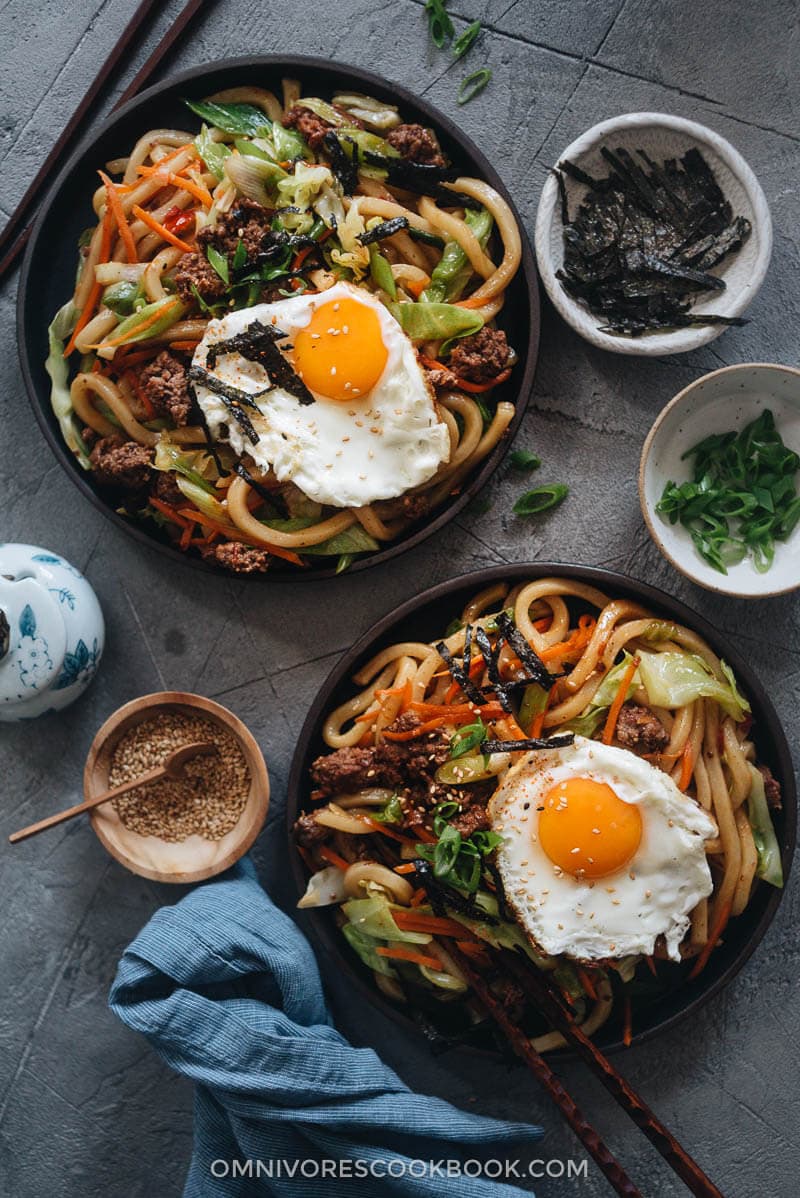
Since moving to New York a few months back, I’ve been sticking to making very simple dishes due to my limited kitchen space. Plus, our gas hasn’t been turned on yet, so you might have noticed that I’ve been posting lots of stew and soup recipes. I do have a portable gas stove, which I use to make stir fries. But more often than not, we stick to one-pot meals that use our electric pot and create minimal clean-up.
Among all the dishes I’ve made recently, this easy fried udon with beef and cabbage is my favorite. Just to be clear, this recipe is not the traditional Japanese-style fried udon that uses mentsuyu and has a refreshingly mild taste. It is quite the opposite. I used very minimal seasonings that you probably already have if you cook Chinese food. The ingredients are so common that you can find them at any grocery store. But the result is magical. The sauce is fragrant and savory with a sweet note. And the noodles are infused with a strong beefy taste that somehow reminds me of a cheese burger.
If you want to make a traditional Japanese yaki udon, you need to look somewhere else. But if you love Chinese takeout and want to add a new easy recipe to your dinner repertoire, this recipe is perfect for you.
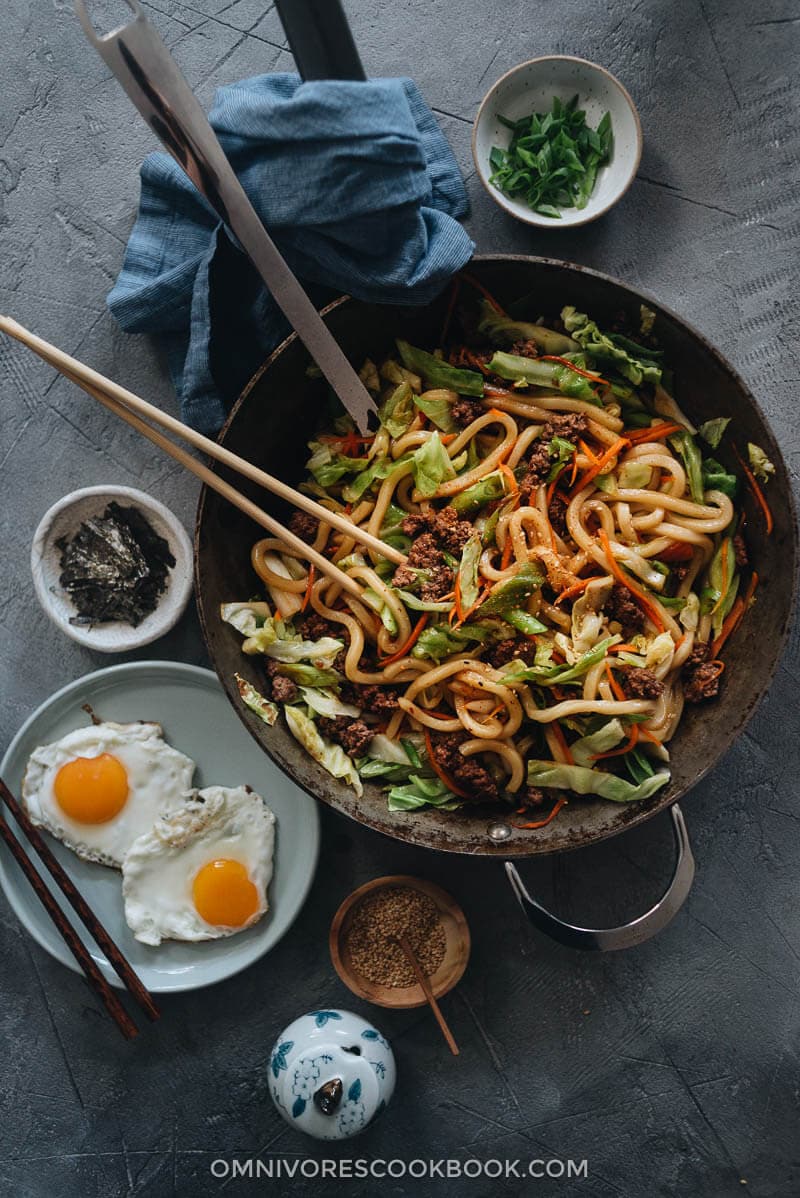
Cooking notes
1. Sauce
Traditional Japanese udon usually utilizes mentsuyu, a mild broth that is made from dried fish and seaweed to add a taste of the sea. However, I did come across different types of yaki udon sauces while living in Japan. For example, I once stayed with a Japanese family in Tokyo when I was a student. They told me that people in northern Japan use slightly bolder sauces and sometimes they make their fried udon using a sukiyaki sauce.
My recipe was inspired by that yaki udon version, only I replaced the mirin with Japanese sake and sugar to mimic the taste of mirin. I also added a small spoon of doubanjiang (the 3-year fermented type from The Mala Market), which adds an extra dimension of umami and a tiny hint of spiciness to the dish. In fact, doubanjiang is also a common ingredient in Japanese cooking and I’ve seen many udon recipes call for a small amount.
2. Why ground beef is always a good idea
Sliced meat is the most commonly used meat in takeout fried noodles and yaki udon. And yes, it does give the dish a more appetizing look and a different texture. But when it comes to home cooking, I always highly recommend ground meat. The advantages of ground meat are:
- It doesn’t require prep. No slicing or marinating needed!
- You won’t overcook it by accident. Unlike sliced chicken or beef, which usually requires high heat and a brief cooking time to yield the best result.
- It tastes amazing with cheap ingredients. Because ground meat releases more flavor into the dish than sliced meat, your veggies and noodles will taste meatier and more delicious.
I used to use ground pork more often while living in China, because beef is not really a staple in northern China. The meat quality is not very good and it can be extremely pricey. After moving to the US, I started to experiment more with beef and the results have been delightful. I’ve found that ground beef infuses a far richer taste into a dish, no matter whether you’re cooking fried noodles or a pot of kimchi stew. And that is the magical ingredient in this recipe to make your fried udon taste like a cheese burger.
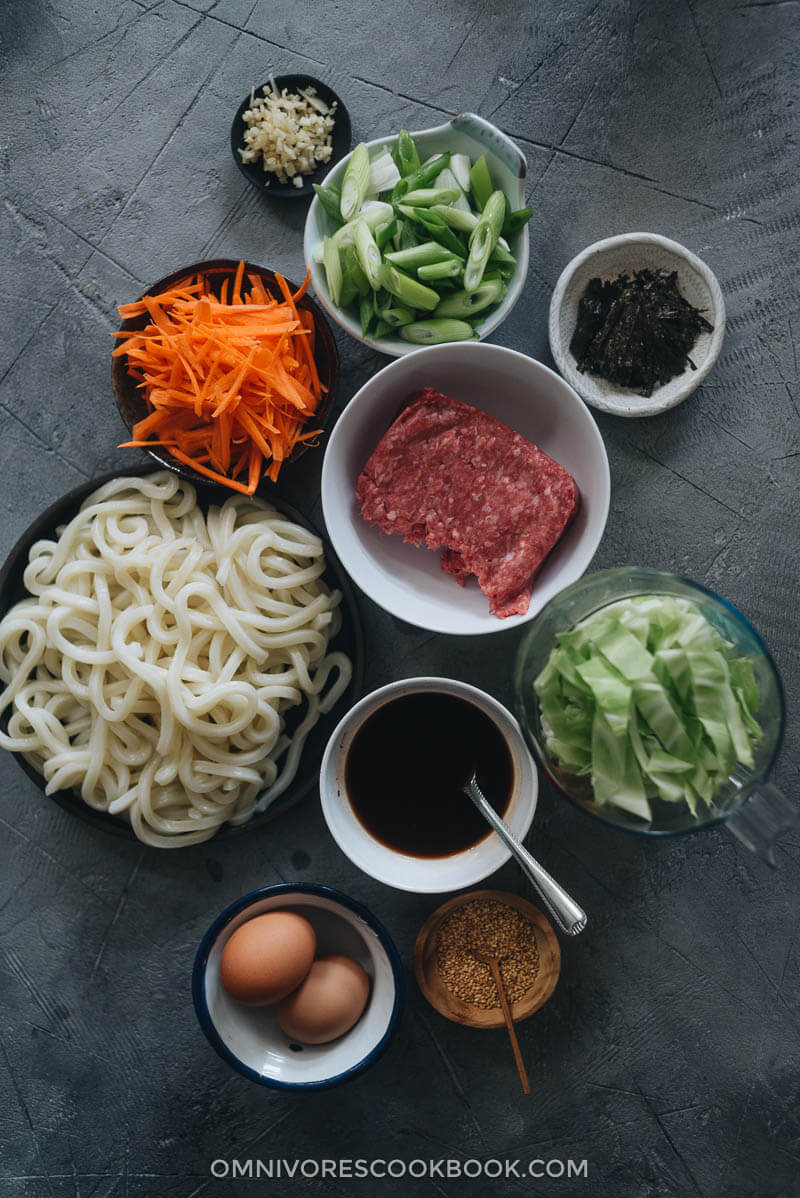
3. A word on noodles
The fat udon noodles are really the key in a fried udon dish. I used to buy the packaged cooked fresh udon while living in Japan. It’s quite hard to find this type in the US, and your next best option is packaged frozen udon. The udon noodles are cooked and frozen. You only need to thaw them (either with a quick blanching or microwaving) before adding it to the stir fry. I really love the fact that you don’t need to boil another pot of water to cook the noodles, since I just have one gas burner to work with.
You probably need to visit a Japanese grocery store to get the correct type. If the dried udon is the only product you can find, you can use it, instead. Please note, the noodles will come out quite narrow and flat, and it won’t look like the dish shown in the pictures here.

4. What pan to use
I used a carbon steel skillet to make this dish. The benefits of this pan are:
- It’s a heavy-duty pan that sears food well, but it’s lighter than a cast iron pan.
- It’s quite nonstick once you season it well.
- It doesn’t have a chemical coating (like a nonstick pan) that might rub off into your food.
The downside is, it is still quite heavy to handle and it does require more oil to prevent sticking. I would definitely recommend a nonstick pan for this dish if you prefer hassle-free.
You can check out this article for more details on why I don’t use a wok.
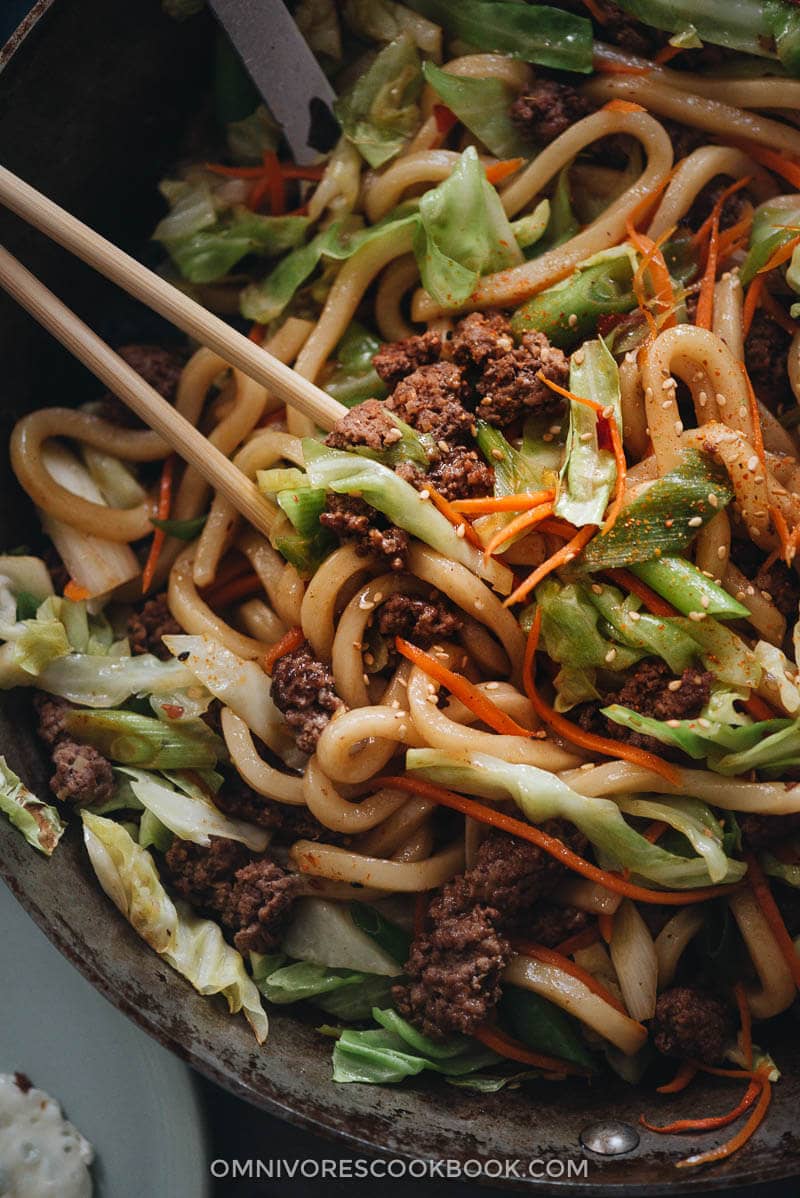
5. A fried egg goes a long way
This fried udon tastes so good that it’s totally fine to make it without the egg topping. But if you want to make the dish perfect, a sunny side up egg (or two!) is the way to go. Alternatively, add a handful of shredded cheese onto your noodles while it’s hot, so the residual heat will melt the cheese. It’s actually a Japanese way to serve rice and noodle dishes, and I think it’s genius. Plus, it’s the perfect add-on for your “cheeseburger fried udon”.
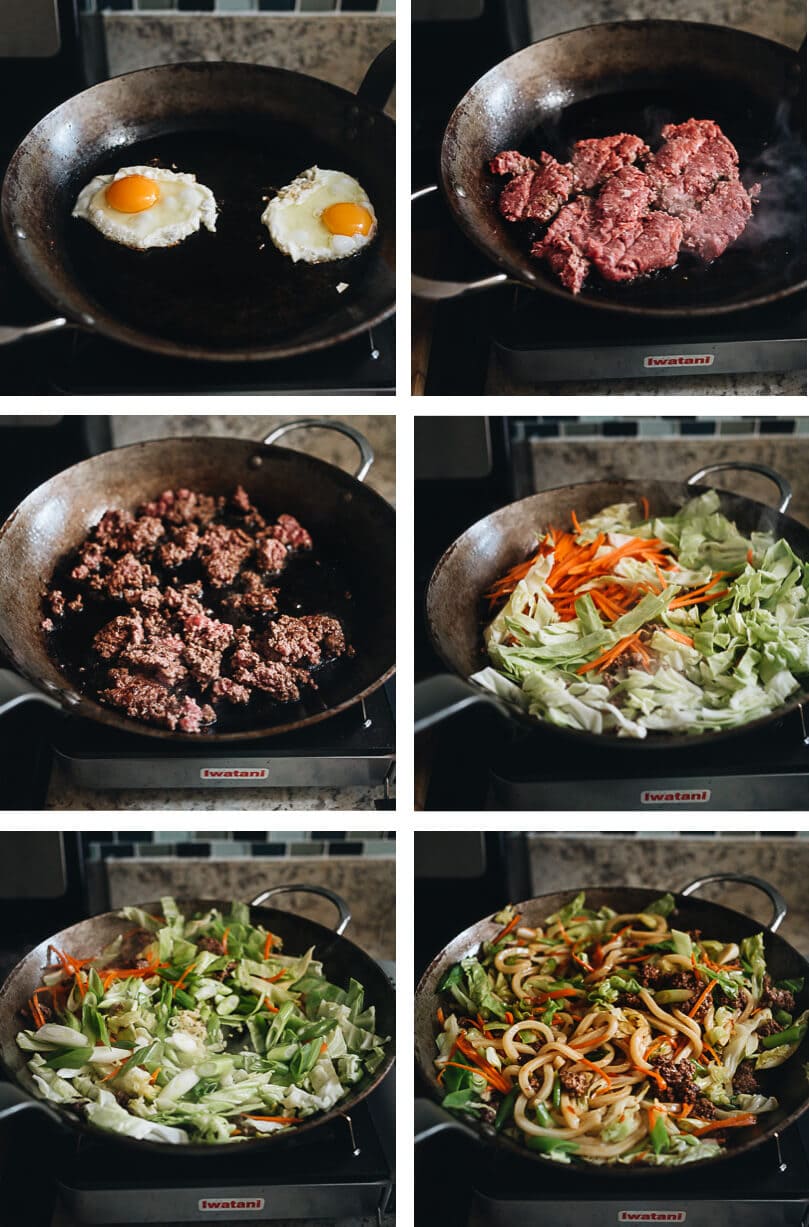
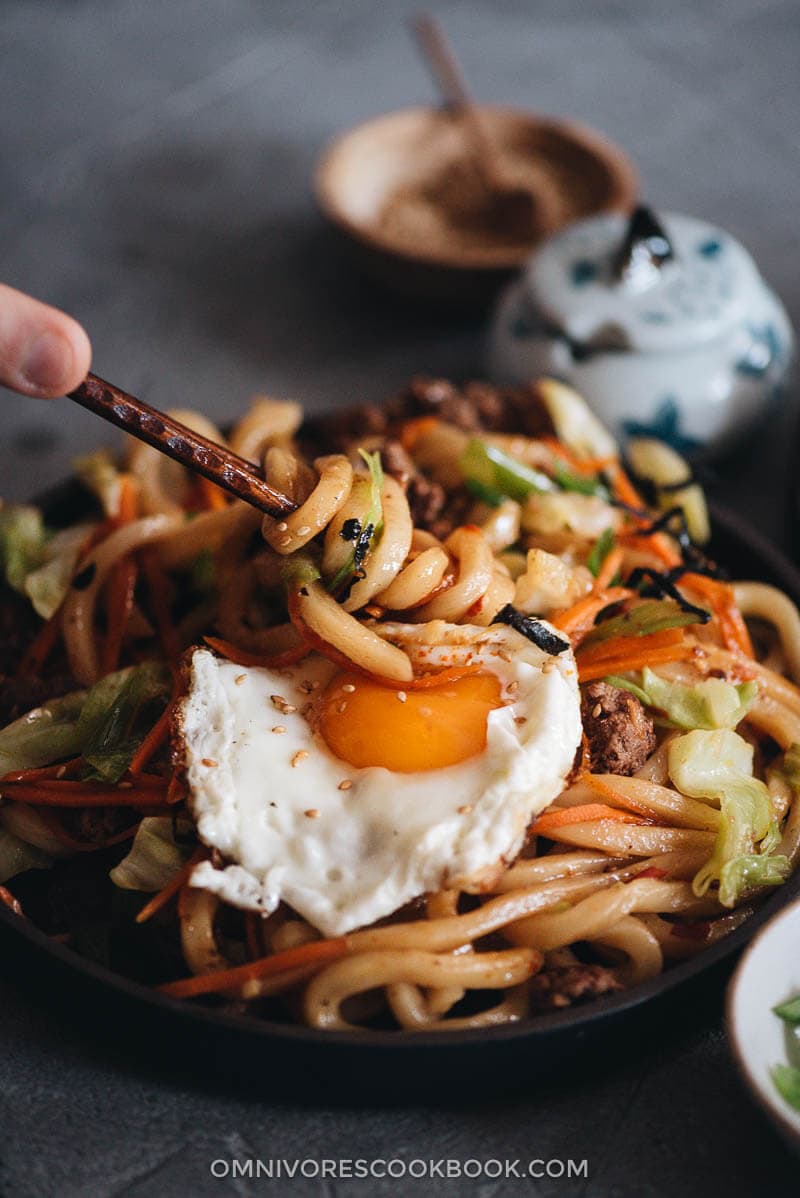
Some updates on New York life
I know I’ve been quite absent from my blog since my move and I haven’t updated it nearly enough as I had hoped. But the good news is, I just learned that our gas will be turned on on July 2nd! Woohoo! I’m glad that we’ll be able to use the oven to roast brussels sprouts and cauliflower again. I’ve been missing them so much.
I hope you like this dish as much as I do! Will be back soon with more delicious recipes.
More easy one-pot recipes
- Korean Army Stew (Budae Jjigae)
- Thai Peanut Butter Ramen
- Easy Pineapple Fried Rice (菠萝炒饭)
- Easy Egg Curry (not quite one-pot but it’s easy to make and you can serve it with bread)
- Chinese Beef Chow Mein (牛肉炒面)
If you give this recipe a try, let us know! Leave a comment, rate it (once you’ve tried it), and take a picture and tag it @omnivorescookbook on Instagram! I’d love to see what you come up with.
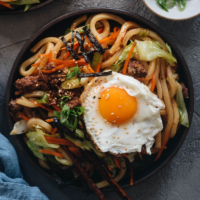
Easy Fried Udon (Yaki Udon)
Ingredients
- 2 packs (17-oz./500 g) udon noodles , frozen
Sauce
- 3 tablespoons Japanese sake (or dry sherry)
- 3 tablespoons soy sauce
- 2 teaspoons sugar
- 1 teaspoon Doubanjiang (fermented chili bean past) (Optional)
Stir fry
- 1 1/2 tablespoons peanut oil
- 1/2 lb (225 g) ground beef (or ground pork, or ground chicken)
- 2 eggs (optional)
- 1 carrot , shredded
- 4 cups cabbage , sliced
- 4 green onions ,sliced
- 2 teaspoons ginger , minced
- Garnish (optional)
- 1 tablespoon toasted sesame seeds , plus more for serving
- Sliced dried nori sheets for garnish
Instructions
- To thaw the noodles, either place them in the fridge overnight, boil them for about 3 minutes, or microwave until just thawed. If the noodles have completely thawed you do not need to boil them. If using dried noodles, follow the instructions on the package. When you’re ready to cook, rinse the noodles with tap water as you gently separate them by hand, and drain.
- Mix the sauce ingredients in a medium-sized bowl.
- Heat a large nonstick pan (or cast iron pan, or carbon steel pawith 1/2 tablespoon of oil until hot. Add the eggs. Cook until the bottom turns golden, the egg white is cooked, and the yolk is still runny. You can also cook the eggs to your desired doneness.
- Add the remaining 1 tablespoon of oil into the pan. Add the ground beef. Cook and break it apart using your spatula. Cook until the meat is lightly browned.
- Add the carrot and napa cabbage. Stir and cook for 1 minute. Add a bit more oil if the pan looks dry.
- Add the green onion and ginger. Stir for 30 seconds or so, to release the fragrance.
- Add back the noodles and pour in the sauce. Stir and mix until the sauce is absorbed. Transfer everything to serving plates. Top with the cooked egg and garnish with sesame seeds and nori.
- Serve hot as a main dish. (This dish keeps well and you can definitely use it for meal prep. Store in an airtight container in the fridge up to 4 days.)
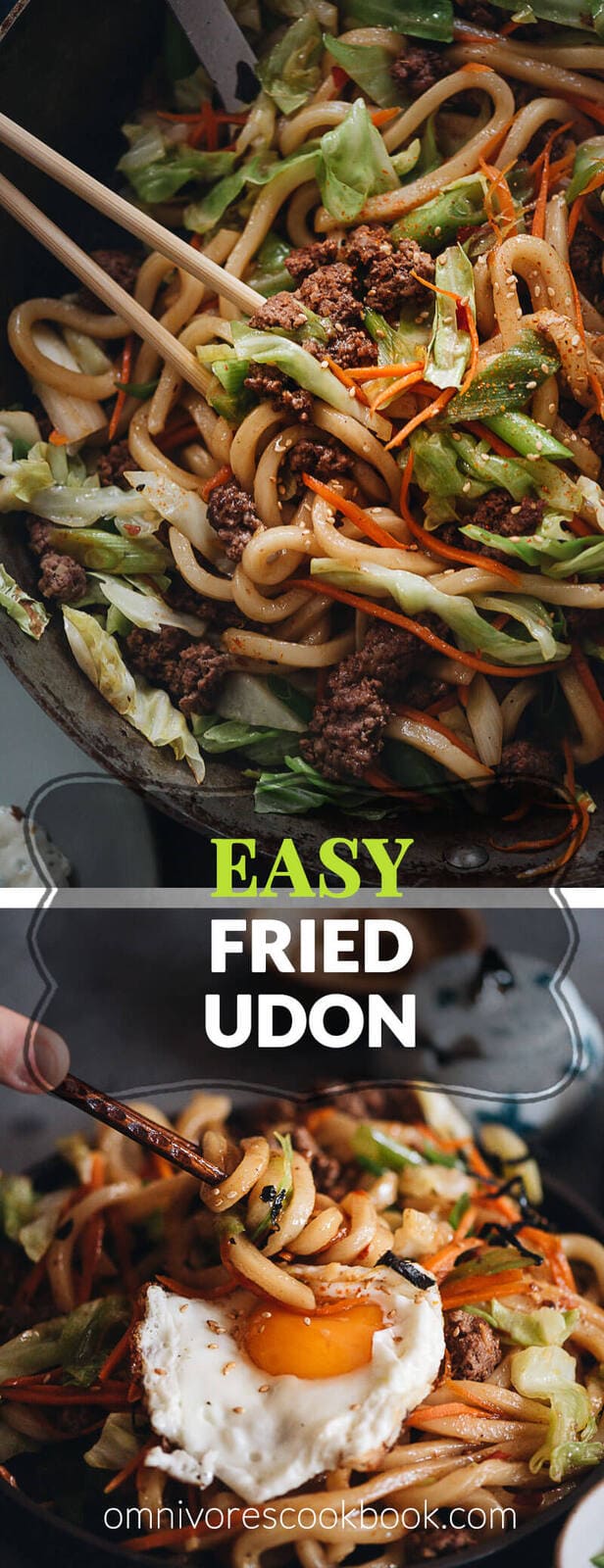













So happy to know that your gas will be turned on in just a couple of days. Versatility in the kitchen is essential to happiness! We wish you much luck in New York.
We enjoy your blog and have learned so much about Chinese cooking through your recipes. Over the past year, through your guidance, I’ve assembled all of the pantry basics for Chinese cooking. We will be making this dish once I acquire fat udon noodles… it looks and read delicious. Thank you, Maggie.
Morning Maggie
I was wondering if your stir fry sauce book, comes in a regular book form?
I would really like to get it, computer books are not good for my eyes. I prefer the written page.
Looks interesting! If I wanted to substitute the peanut oil though, what would you recommend using instead?
Hi Sarah, you can use any neutral oil to replace it, such as grapeseed oil and vegetable oil etc.
Nos autorizas a citarlo en mi sitio web. Gracias Saludos
Very tasty, will make it again. I added some leftover lotus root. But would use only half of udon for better balance between veggies and noodles.
So easy and delicious. Really tastes like a cheeseburger udon
Brilliant recipie, easy to make and great taste!
I haven’t tried making this one yet but I can already taste it in my mouth 🤤
What would you recommend as a substitute for those of us who cannot do gluten?
Really appreciate your help and love your work!
I think rice noodles would be your best bet, especially if you can find the wide type (either fresh or dried) for a nice texture.
The dried ones look like this: https://amzn.to/3xRhXea
The fresh one is harder to find and you will need access to Asian markets or Chinese grocery stores. They look like the noodles used in this recipe: https://omnivorescookbook.com/drunken-noodles/